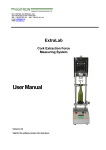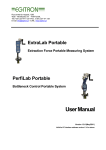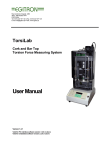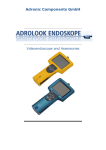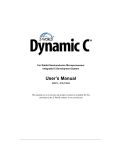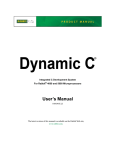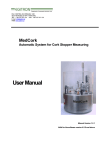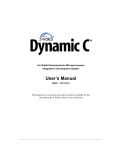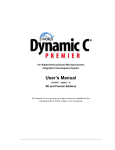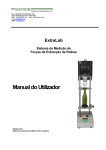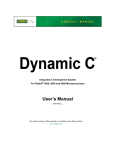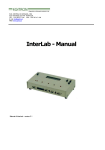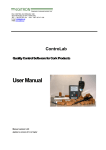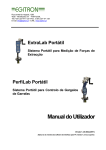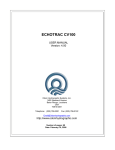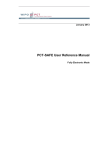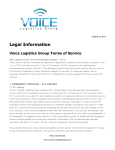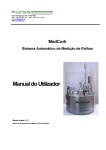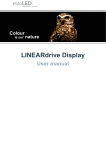Download Operation Manual
Transcript
Rua Central da Vergada, 1280 4535 - 166 Mozelos VFR PORTUGAL Tel (+351) 227 471 120 E- ExtraLab Plus Extraction Force and Torque Measuring System Operation Manual Version 1.0.0 Valid for PC interface software version 1.3.0 Valid for firmware version 1.5.0 ExtraLab Plus Cork Extraction Force and Torque Measuring System RESPONSIBILITY EXEMPTION This manual was written and revised to explain the ExtraLab Plus characteristics and functioning in the most correct way possible, particularly regarding PC interface software. However, this user manual and/or the equipment may be changed without previous notice. EGITRON is not responsible for any damage caused by any direct or indirect error, omission or discrepancies between the ExtraLab Plus operation and the instructions presented in this Manual. This document, or any part of this document, cannot be reproduced or transmitted under any format and for any purpose, without EGITRON written permission. TRADE MARKS Excel, Windows and Microsoft are Microsoft Corporation registered trademarks. Other trademarks or registered trademarks not listed above can be used in this manual. CONFORMITY DECLARATION This product exhibits CE marking, according to European Union applicable directives. GENERAL PRECAUTIONS EGITRON equipment is produced to optimize security and minimize effort. Nevertheless, certain precautions should be taken to reduce the risk of human physical damage or equipment damage. Please read carefully the general precautions presented below and take attention to the warning signs in this manual. Keep away from children; The machine should be operated only by persons with the appropriate training; Do not remove any cover or mechanical protection; All maintenance should be executed by specialized technicians; III / 58 ExtraLab Plus Cork Extraction Force and Torque Measuring System The machine should not operate on facilities with severe environment conditions, like dust or humidity; The equipment should be connected to the ground by the power supply plug; In case of successive power supply breakdowns, the equipment should be disconnected from the power supply; The equipment transport and handling should be done with extreme precautions, as it has fragile parts. For transportation use an adequate packaging so that the machine remains well accommodated and protected. WARRANTY AND TECHNICAL SUPPORT EGITRON guarantees the correct functioning of its products, in general for 1 year, or for a different period whenever specifically written. The warranty covers workmanship and materials but not the equipment transportation or onsite displacements, which will be charged according to the standard prices in practice at the time. This is valid with the exception of the first onsite displacement or equipment transport, if required within the first month of the warranty period, which will be free. In this last case, EGITRON will decide the most appropriate option between the technician onsite displacement or the equipment transportation to EGITRON facilities and back to the client. If the equipment presents any malfunctioning during the warranty period, EGITRON, according to its own criteria, will repair or replace it without any charge, except in the situations described below. Any product and/or part that have been replaced will become EGITRON property. The warranty will have no effect in malfunctioning resulting from causes non imputable to the equipment, such as: Anomalies caused by maltreatment, recklessness or handling contrary to the manual instructions; Modifications or incorporations of non-authorized parts, and/or done by non-authorized personnel; Defects caused by short circuit or mechanical injury; Indemnities for personal or material damages directly or indirectly caused by the equipment; IV / 58 ExtraLab Plus Cork Extraction Force and Torque Measuring System Defects caused by any installation service or user training at client facilities, when not directly imputable to EGITRON technicians; Equipment replacement. To request warranty services contact the EGITRON technical support. EGITRON can ask for the purchase proof / equipment invoice. This equipment is suitable only for its design purposes and EGITRON is not responsible for its improper use. In case of malfunctioning or request for technical support Before asking for EGITRON support read the Problems Resolution chapter, call your company technical support (if available) and/or use all existing auto-help tools. If the problem remains unsolved contact EGITRON, having with you the following information: Equipment name Serial number Purchase date Problem description Error message that may appear. You can contact EGITRON by: Phone: (+351) 227 471 120 Fax: (+351) 227 471 129 E-mail: [email protected] Post: Rua Central da Vergada, 1280 4535-166 Mozelos VFR - PORTUGAL V / 58 ExtraLab Plus Cork Extraction Force and Torque Measuring System INDEX WELCOME NOTES ................................................................................................................................................. 8 MANUAL CONTENTS............................................................................................................................................. 8 1. CONVENTIONS ............................................................................................................................................... 9 2. EXTRALAB PLUS AND PC INTERFACE SOFTWARE SETUP ................................................................ 9 2.1. 2.2. 2.3. 2.3.1. 2.3.2. 3. ACCESSORIES SUPPLIED ................................................................................................................ 9 PC INTERFACE SOFTWARE SETUP AND CONFIGURATION ..................................................... 9 MACHINE SETUP .............................................................................................................................. 11 Back acrylic cover .................................................................................................................................................................... 11 Connecting ................................................................................................................................................................................ 11 OPERATION AND EQUIPMENT FEATURES ............................................................................................ 12 3.1. 3.1.1. 3.2. 3.2.1. 3.2.1.1. 3.2.2. 3.2.3. 3.2.4. 3.2.4.1. 3.2.4.2. 3.2.4.3. 3.2.4.4. 3.2.4.5. 3.2.4.6. 3.2.4.7. 3.2.5. 3.2.6. 3.2.7. 3.3. 3.3.1. 3.3.2. 3.3.3. 3.3.4. 3.3.5. 3.3.6. 3.3.7. 3.3.8. 3.4. 3.4.1. 3.4.2. 3.4.3. 3.4.4. 3.4.5. 3.5. 3.5.1. 3.5.2. 3.5.3. 3.5.4. 3.5.5. GENERAL ASPECTS ........................................................................................................................ 13 Equipment description ............................................................................................................................................................ 13 CONTROL THROUGH THE COMMAND BOX................................................................................ 15 Operation Basic Concepts ...................................................................................................................................................... 15 Template for values introduction ...................................................................................................................................... 16 Welcome Window..................................................................................................................................................................... 17 Main screen ............................................................................................................................................................................... 17 Configuration Menu ................................................................................................................................................................. 18 Test Type .............................................................................................................................................................................. 18 Test Mode Configuration .................................................................................................................................................... 19 Sealing Configuration ......................................................................................................................................................... 19 Set clock ............................................................................................................................................................................... 20 Set date ................................................................................................................................................................................. 20 Language.............................................................................................................................................................................. 20 ................................................................................................................................................................................. 20 Calibration screen .................................................................................................................................................................... 20 Initialization ............................................................................................................................................................................... 22 Stopping movements............................................................................................................................................................... 23 PC PROGRAM ....................................................................................................................................... 23 Data Tables................................................................................................................................................................................ 24 Report Configuration ............................................................................................................................................................... 25 Acquire Values.......................................................................................................................................................................... 26 Saving Reports ......................................................................................................................................................................... 28 Open Reports............................................................................................................................................................................ 29 Printing Reports ....................................................................................................................................................................... 29 Export to Excel.......................................................................................................................................................................... 30 Calibration ................................................................................................................................................................................. 31 COMMON EQUIPMENT AND SOFTWARE OPERATIONS .......................................................... 33 States ......................................................................................................................................................................................... 33 Test Configuration.................................................................................................................................................................... 33 Values Acquisition ................................................................................................................................................................... 35 Deleting Test ............................................................................................................................................................................. 35 Safety and Protection .............................................................................................................................................................. 36 START A TEST................................................................................................................................... 36 Connect the equipment ........................................................................................................................................................... 36 Place the bottle ......................................................................................................................................................................... 36 Configure the test ..................................................................................................................................................................... 37 Starting the Test ....................................................................................................................................................................... 37 Check information on the Display .......................................................................................................................................... 38 4. EQUIPMENT MAINTENANCE ..................................................................................................................... 39 5. TROUBLESHOOT ......................................................................................................................................... 40 5.1. 5.2. 5.3. CALIBRATION CURVE LOAD FAILURE AT STARTUP ............................................................... 40 COMMUNICATION ERROR.............................................................................................................. 40 SYSTEM BLOCKED .......................................................................................................................... 40 6 / 58 ExtraLab Plus Cork Extraction Force and Torque Measuring System ANNEX A OPERATOR INTERFACE MENU TREE ......................................................................................... 41 ANNEX B ACCESSORIES ................................................................................................................................. 42 1. 2. ANNEX C 1. 2. 3. ANTI-SPLASH PROTECTION APPLICATION............................................................................................... 42 CLAMPS ................................................................................................................................................ 42 CALIBRATION ................................................................................................................................... 44 CALIBRATION SETUP ............................................................................................................................. 44 CALIBRATE EXTRACTION....................................................................................................................... 45 TORQUE CALIBRATION .......................................................................................................................... 49 ANNEX D FIRMWARE ACTUALIZATION ........................................................................................................ 53 ANNEX E COMMUNICATION CABLE .............................................................................................................. 55 ANNEX F TECHNICAL SPECIFICATIONS ...................................................................................................... 56 NOTES .................................................................................................................................................................... 57 7 / 58 ExtraLab Plus Cork Extraction Force and Torque Measuring System WELCOME NOTES Congratulations for purchase ExtraLab Plus Extraction Force and Torque Measuring System. With this excellent equipment it is possible to assess the closure quality thru the analysis of different physical tests, namely extraction force, opening torque, closing torque or breakage resistance, following the standards in practice, allowing the user measuring a simple and reliable way to perform these tests. The users have at their disposal an equipment of control, with small dimensions, developed with metrological precise techniques, assuring, a high standard and innovative quality control. ExtraLab Plus is supplied with software for Windows compatible with all Microsoft Windows 9x/Me/NT/2000/XP/Vista/7 operating systems. This software was specifically developed for the ExtraLab Plus and it allows the user to: Monitor the equipment; Collect the tests data from the ExtraLab Plus and present them graphically; Save the tests into a database for later use; Print reports in several languages; Setup the quality control tests configuration; Perform equipment calibration; Export data to Microsoft Excel. This operation manual contains instructions to setup the ExtraLab Plus, providing detailed information regarding its operation. MANUAL CONTENTS This operation manual describes the ExtraLab Plus and also the PC interface software. It starts with ExtraLab Plus characteristics, the setup procedure, the connection to a PC and the interface control software setup. After the setup, are described the ExtraLab Plus functionalities; the test process and the data acquisition thru the interface software. In the following chapters, you can find information about saving the tests, opening saved tests and printing reports. Next, the operation manual explains how to export data to Microsoft Excel. At the end, the equipment calibration, maintenance and troubleshooting are described. 8 / 58 ExtraLab Plus Cork Extraction Force and Torque Measuring System 1. CONVENTIONS Abbreviations: In this operation manual you can find the following abbreviations: ExtraLab Plus Report Test PC Extraction Force and Torque Measuring System Group of tests on one or more corks Extraction/Detaching/Rupture test for a single cork personal computer Messages Some messages are used in this manual to call your attention for important information. Each message type is identified as follows: Pay attention! A warning signal informs that an improper equipment use or not following the instructions, can cause personal and/or equipment damages. Please read. This is a suggestion or advice which can help you to get more benefits from the equipment. 2. EXTRALAB PLUS AND PC INTERFACE SOFTWARE SETUP 2.1. ACCESSORIES SUPPLIED Along with this user manual you can find the following items: 1. Installation Guide; 2. CD with software interface for PC; 3. Set of accessories, according to the order made and as the package contents sheet. 2.2.PC INTERFACE SOFTWARE SETUP AND CONFIGURATION To install the PC interface software, please follow the next steps: 1. Place the setup CD at the computer CD/DVD drive; 9 / 58 ExtraLab Plus Cork Extraction Force and Torque Measuring System 2. Using the Start button, select the Run \Setup\ the CD/DVD drive letter. If the CD-ROM is accessed by another letter, the user must type the corresponding CD-ROM letter. Afterwards press Enter. The installation program must be executed following the indications until the installation is successfully completed. The user can also run , accessing installation CD thru using Windows Explorer. After software installation, the user can start the Interface Plus ExtraLab programs menu (or a desktop shortcut may be created). At startup, the software makes a communication test with the equipment. If there is no communication, the user receives a warning with the possible causes. In this case, some software options are inactive, including the option of performing tests. However, the user can still see the existing tests on the Database and print some reports. The most common causes for communication failure are: 1. Equipment not connected: connect the ExtraLab Plus (see next chapter). 2. The connection with the communication cable is not correct (see next chapter). 3. Communication parameters are not correct: For changing the communication settings the user should select menu at the main toolbar. After this, a new window like Figure 1 shows up. On the interface software it is possible to configure the PC serial port number (COM) where the communication cable is connected, communication including and the settings, Baud-Rate, parity, bits number and Figure 1 Communication settings Stop bits number. The communication settings for ExtraLab Plus are: N, 8, After checking the causes for the communication fail, it will be necessary to press Test on the communications settings window (Figure 1) or press the identical button on the main window to test the communication with the equipment. If successful all software options will be activated. 10 / 58 ExtraLab Plus Cork Extraction Force and Torque Measuring System 2.3.MACHINE SETUP Before making any connection it is very important that the user understands the technical specifications of the machine (see Annex F). The technical specifications and the information next to the connectors must be followed, otherwise damages in the equipment may occur which will not be covered by the warranty (see warranty conditions above). In case of doubt, please contact EGITRON for technical support. 2.3.1. Back acrylic cover a) After placing the equipment at its Apply the cover workplace. b) Apply the back cover (when supplied Screw with the existing separately) on the back of the screws (4) equipment and tight it with the existing screws. Figure 2 - Back cover application 2.3.2. Connecting a) Connect the ExtraLab Plus equipment to the pneumatic feeding thru the pneumatic connection on the back panel. The feeding tube should have 6 mm of diameter (type FESTO PUN-H-6x1-nt) and the pressure must be between 6 and 8 bar. b) Connect the power cable according the indication on the label next to the power connector (Figure 7 - Command Box). c) Connect the communication cable on the PC communication port. If the PC only has USB ports available, use a RS232/USB converter (If required contact EGITRON to order a RS232/USB converter). Figure 3 - PC Serial Communication Ports RS232 Figure 4 - ExtraLab Plus Serial Communication Port (Rear Command Box) 11 / 58 ExtraLab Plus Cork Extraction Force and Torque Measuring System 3. OPERATION AND EQUIPMENT FEATURES On this chapter we will explain the functionalities of ExtraLab Plus, including the control by the command box and the control by the interface software, in order to enable the user to correctly operate the equipment and perform tests. On the next subchapters, the most important aspects to consider when operating ExtraLab Plus will be analyzed, so that, after a careful reading the user will be able to fully operate the equipment and understand some less intuitive operations . Upper group of the equipment (encoder + extraction motor) Measurement unit (Extraction +Detaching) Gripper Working area Security door Elevation Base Power Switch ON/OFF Adjustment Command Box EMERGENCY button Command Console (Keys and display) Figure 5 - ExtraLab Plus (front panel) 12 / 58 ExtraLab Plus Cork Extraction Force and Torque Measuring System Pressure gauges Communication port Programming port Compressed air feeding (6mm) (GRIPPER) (ELEVATION) Pressure regulators Calibration buttons Power connector Figure 6 - ExtraLab Plus (back panel) 3.1. GENERAL ASPECTS 3.1.1. Equipment description The ExtraLab Plus has a tower format, supported by two cylindrical guides and an aluminum enclosure which contains the electronic control (commands and processing unit). On the next paragraphs, we will describe the main parts. The upper group of this equipment is composed by: a motor which is responsible by the extraction movement, a vertical position sensor (encoder) and the initial position sensor; a lever to hold / release the security door Below there is the measurement unit, composed by two load cells, used to measure the extraction force and torque. In this unit, there is also a motor and a sensor for the torque movement. Finally there is a gripper and a set of optical fibers to detect the approach to the closure. Below the measurement unit, there is the working area, used for positioning the bottle, adjusting the measurement unit to the test type and performing tests. On the lower part of the equipment, there is the command box which contains the electronic control system. On the frontal panel of the command box, there are the following items: 13 / 58 ExtraLab Plus Cork Extraction Force and Torque Measuring System Operator interface where it is possible to easily operate the equipment. Regulators to set the speed of the extraction test and the torque test Emergency button to stop the equipment in case of emergency. Power Switch ON/OFF that allows the user to turn-on and off the equipment. On the command box back panel, illustrated in Figure 6, the user will find the power supply connector, the communication and programming ports. The first used to communicate with the PC and the second used port is used for programming the machine and it should not be used except when performing a firmware update. For more details, please see ANNEX D Firmware Actualization that contains information related to firmware update. On the right of the power plug, there are two red buttons (one for the Extraction load cell and another for the Torque load cell), used for checking if there are discrepancies between the factory calibration values and the current values. Over the right side, there is the plug for compressed air where the pneumatic connection is done. And there are also two pressure gauges that indicate the pressure for the elevation cylinder (Elevation) and the pressure applied on the pneumatic Gripper (Gripper). To adjust the pressure there is a regulator for which actuator (gripper and elevation cylinder). Both adjustments are important: Gripper pressure: should be adjusted to prevent the sliding of the cork when testing champagne or bar top cork, without damaging the cork. Generally, the pressure should be between 2 and 2.5 bar, however the operator should adjust the equipment pressure having in mind the following scenarios - Insufficient pressure: - Excessive pressure: After the test, the cork stopper shows damage, for example disruptions in the clamps tightening area. This will change the test values. Elevation cylinder pressure: adjust so the bottle is not too much compressed against bottle positioner (it may burst) and so the bottle does not rotate during torque tests. Generally the pressure should be between 4 and 4.5 bar. Please find information about the accessories usage at ANNEX B Accessories. 14 / 58 ExtraLab Plus Cork Extraction Force and Torque Measuring System 3.2. CONTROL THROUGH THE COMMAND BOX Figure 7 - Command Box 3.2.1. Operation Basic Concepts In this chapter we will be explain the basic concepts of navigation between the different windows available in the operator interface (display) that is in the command box, as illustrated on Figure 7. On de operator interface there is a graphic display and a keypad. There are three operating modes: Test Mode: the default mode, in which it is possible to perform tests. Calibration Mode: accessible through Figure 8). In this mode are provided some features for calibration and for performing movements. Configuration Mode: accessible through Figure 8), where it is possible to configure the equipment and configure also the test to be done. On the display it will be available, at every time, the information related with the active mode, i.e., the display will show information related with the tests when in test mode, will show information about calibration in calibration mode and will show the configuration menus when in configuration mode. 15 / 58 ExtraLab Plus Cork Extraction Force and Torque Measuring System The keys are the control means available for navigating between the different modes. These also allow to command individual A movements (Calibration Mode) and to configure the equipment (Configuration Mode). The keys have the following functionalities: C B Function Keys (Figure 8/A): These keys Figure 8 - Keys of the console command the equipment according to the function that appears on the lower edge of the display. Navigation Keys (Figure 8/B lighter background): these keys assume distinct functions depending on the mode. Further the keys keys and and will be designated Central Key (Figure 8/C): The role of this key will also depend on the active mode. On Test Mode the function is for , or start the equipment depending on the equipment status. On Calibration mode, it will be for raising the base for bottle elevation and on configuration mode it will be used to confirm the selected option. 3.2.1.1. Template for values introduction On the configuration menu there are some templates for introducing values (Figure 9) which will be validated by the range of values indicated on the upper side of the screen. To select a value, browse through the characters available and press the central key to confirm the value. Repeat this operation until the end of the introduction. To confirm introduced is out of the validation range, this introduction will not be Figure 9 Values introduction allowed. 16 / 58 ExtraLab Plus Cork Extraction Force and Torque Measuring System 3.2.2. Welcome Window Press the el of the command box to start the equipment. At starting, a welcome screen will appear with an indication of the installed Firmware version (Figure 10). After 2 seconds the main screen will show (Figure 11). Figure 10 - Welcome screen 3.2.3. Main screen The main screen is illustrated on Figure 11. Here it is A represented, in a condensed way, the memory state, the B tests results, the current test configuration and time and C date information. For better understanding the different information areas, these were identified in Figure 11 by D letters, whose meanings we will describe below. E Figure 11 Main screen A. Information about time and date (chapters 3.2.4.4 and 3.2.4.5). B. Information about memory state: on the example we have Test 1 that has been visualized in a TOTAL of 1 test in memory. C. Current test configuration, in this example we have the Test Type T + E (chapter 3.2.4.2), Cork Type Plus (chapter Error! Reference source not found.) and Torque Angle 75 degrees (chapter Error! Reference source not found.). D. Information about test results: On the example above, the Torque test had the maximum value of 12.8 daN.cm at 28º and the Extraction Test had the maximum value of 12.3 daN at a displacement of 2 mm. If one of the tests was not done, asterisks (****) will appear on the corresponding column. Use the horizontal arrow keys to navigate between the tests in memory. E. Functions: show the modes / functions available since the main window: CALIB: Enter in the calibration screen (see chapter3.2.5). START: Start a test (it may also be done by the central key). CONFIG: Enter in the configuration menu (see chapter3.2.4). DELETE: Open the confirmation screen in order to delete all tests in memory. 17 / 58 ExtraLab Plus Cork Extraction Force and Torque Measuring System 3.2.4. Configuration Menu The configuration menu gives access to a set of settings that allow the user to choose some generic parameters, such as language, date, time, and other parameters related with tests preparation. These last parameters should be adjusted every time the user starts a new report (set of tests) according with the test type to perform. To access the configuration menu, press and the display should show the configuration menu (Figure 12). Before we present each menu, it is important to have in mind the following concepts, concerning the navigability within the menus. As seen in 3.2.1 the keys up and down allows the navigation between the available options Figure 12 Configuration Menu The central key selects the highlighted option being a submenu selection or a value selection. Every time the user wants to leave a menu, select the ke e right. Next press the central key to confirm. After this, the program returns the previous menu or exits the configuration menu and returning to the main screen (for an overview of the screens tree see ANNEX A Operator interface menu tree). 3.2.4.1. Test Type The ExtraLab Plus allows the execution of 4 test types: Champagne/Capsulated; Still Wine Cork; Screw Cap; Breakage. Figure 13 Test type configuration 18 / 58 ExtraLab Plus Cork Extraction Force and Torque Measuring System 3.2.4.2. Test Mode Configuration The ExtraLab Plus allows the execution of 6 test modes. To ease the identification of each test mode on the main screen, these were coded through related letters. Next we will describe the different tests types and the associated letters: Figure 14 Test mode configuration Extraction (E): Only extraction test, without any rotation movement. Torque (T): only detaching test. The measurement unit moves towards the closure (cork stopper or bar top), detaches it and at the end releases it without removing it from the bottle. Torque + Extraction (T + E): Torque (detaching) test followed by Extraction test. Torque and Extraction (T & E): Torque (detaching) test performed simultaneously with the Extraction test. Overtorque (T): Overtorque test. Torque + Overtorque (T+O): Torque (detaching) test followed by Overtorque test. 3.2.4.3. Sealing Configuration Based on this parameter, the measurement unit will define the position of the clamps on the pneumatic gripper. The user can select one of the five options available. The sealing configuration, is also coded to ease the visualization on the main screen. The sealing options are: Champagne (Plus): 19 mm; Long Cap (Cap A): 15 mm; Short Cap (Cap B): 5 mm; Figure 15 Sealing configuration Poly: 24 mm; Other (D(xx)): The distance may be set by the user, being xx a value between 5 and 30 (24mm for models before serial number 005). Selecting this option, the user will have to manually introduce the exterior cork length value (part of the cork that that remains out of the bottle), according to the range validation and as referred on the chapter 3.2.1.1. 19 / 58 ExtraLab Plus Cork Extraction Force and Torque Measuring System The appropriate configuration for the sealing type is very important. An incorrect configuration can damage both the equipment and the bottle to be tested. 3.2.4.4. Set clock After selecting this option, the user will have to use a value introduction template to enter the current time. Which must be done according with the indications in chapter 3.2.1.1 and following the time representation on the top of the template (HH-MM-SS) in an 24 hours format (example: 13-10-00 to 13 hours, 10 minutes and 0 seconds). 3.2.4.5. Set date In this menu the user can set the date thought a value introduction template. This must be completed according with the indications in chapter 3.2.1.1 and according to the date representation on the top of the template (DD-MM-YYYY ex: 24-10-2009). 3.2.4.6. Language In this menu it is possible to choose the language that the user wants for the equipment operation. The options are Portuguese and English (Figure 16). Figure 16 Language 3.2.4.7. Screen with information about the embedded software (Firmware) and EGITRON contacts. 3.2.5. Calibration screen Pressing the Figure 11), it is possible to access the calibration screen (Figure 17). In used in each test type and is also available a set of commands which allow to command manually the equipment. Figure 17 Calibration screen 20 / 58 ExtraLab Plus Cork Extraction Force and Torque Measuring System The calibration operation must be performed by an operator with high level of responsibility and technically able to perform this operation. In this mode, some of the security functions of the equipment will be inactive. Therefore it is recommended to keep, as far as possible, the protection door closed and to have a very careful attitude whenever performing any command. In case of doubt, please contact EGITRON. Next we will describe the information fields and after the available commands. Information fields: Vel: this field indicates the velocity on Extraction test and on Torque test. The reading of the velocity is made only on the relevant movement of the test, for example during the ascendant movement in Extraction test or during the counterclockwise rotation movement on Torque test. ADC: represents the digital result of the analogical signal conversion from each load cell. This value is important for the calibration procedure and to verify calibration value (see procedure for calibration on ANNEX C Calibration). For / Mom: This is the result of the digital value (ADC) conversion into a Force value or Torque value. Below force or torque value there is a graphic bar associated the respective value. Available controls: MAXIL: Allows opening and closing the pneumatic gripper. ZERO: Allows sending a Zero (Tare) command to each of the load cells (Extraction and Torque). Central Key: Allows the command of the cylinder responsible for moving the elevation base (up and down). This action can be useful to verify the use of a certain type of bottle concerning the position of the bottle in respect the centering bar when the elevation base is at top (e.g. short bottles have to be tested using the supplied short bottles support see installation guide). Navigation Keys and : allow starting the pneumatic gripper rotation movement, on each direction, simulating the Torque test. Navigation Keys and : allow to setup descent and ascent movements of the measuring unit. In order to guarantee some security, some of the implemented rules should be held in mind: 21 / 58 ExtraLab Plus Cork Extraction Force and Torque Measuring System On calibration mode, if the measurement unit is not in the initial position (top), the system does not allows the descent movement. First, the user must place the measurement unit to its initial position (all the way to the top). There is an imposed limit for the descend movement. This limit prevents the measurement unit to hit the bottle support, but does not protect the equipment if any obstacle is placed on the path of the measurement unit. The readings of the load cells are activated during the up and down movements in order to prevent the system from overloading the load cell. 3.2.6. Initialization In order to start a test, the system needs to verify all the startup conditions. Case these are not verified, the user should initialize the system. During initialization the following operations are executed: Reposition the movable parts in their original positions; Check the system sensors (position sensors, gripper obstruction, load cells values, security door position, etc.). Figure 18 Inicialize It is necessary to carry out the Initialization every time the equipment is at a non-Initialized status. This happens when: the equipment is turned-on and before performing the first test; whenever a test is aborted; when a free movement is done during the Calibration mode, after the occurrence of an important error on the equipment. It is also necessary to initialize the system whenever the bottle type is changed. The reason for this is that in order to minimize the test time, the measurement unit stops at an intermediate position according with the bottle being tested. Therefore when changing the bottle type, the system should be initialized, once the intermediate position may not adjust to the new bottle type. 22 / 58 ExtraLab Plus Cork Extraction Force and Torque Measuring System 3.2.7. Stopping movements The operator can stop at any moment, any equipment action by performing the following step: At the Command Box bottom. After executing the stop command, it will not be possible to continue the testing, without initializing the system. 3.3. PC Program The software was developed having in mind that it could be used by any person, not requiring much computer knowledge. Hard work was evolved to make it a very user-friendly interface. All input data is properly validated, and the user is notified if any data is not valid or if any operation is not possible, cutting to minimum the chance of introducing errors. By this way, we assure that the equipment will not carry out any operation that can put in risk the operator or even the equipment. The user can try by himself if it is or not possible to enter a specific value or to carry a specific operation. General Menu Results Status Toolbar Visualization and configuration of the test type and parameters Command Toolbar Info Toolbar Figure 19 Main window of the control program Whenever it is necessary to explain a particular value or button in the software windows, there are yellow sticks with a brief description which can be opened by moving the mouse over that value box or button. 23 / 58 ExtraLab Plus Cork Extraction Force and Torque Measuring System After starting the program, the main window is presented (Figure 19). On this window there are available several functionalities and from it the user can access to all the available menus and windows. On the top side there is the main menu where it is possible to access to other program windows, as configuration, calibration, reports, tables, saving and consulting saved tests etc. On the right side of the window, one will find a Status toolbar that contains some information about the equipment status. This information appears in a form of a picture (fixed or intermittent) and additionally there is an info toolbar at the bottom of the main window with short messages which shows information on the equipment status. Still on the right side, there is also a section where some test configuration parameters are visualized. The user can choose a Test Type configuration, and all of the configuration parameters will be sent to the machine. Bellow, on the right low corner of the window, there is a Command toolbar that contains buttons associated to procedures like reading values from the equipment. The main part of this window is filled by the Results area that contain the values and graphics of the tests performed or of a report previously saved in the program database. On the following chapters we will explain with more detail, all the potentialities of this equipment and its interface software, like changing tests configurations, consulting recorded tests and performing the equipment calibration. 3.3.1. Data Tables There are several data tables, which help identifying the report and its execution conditions. When saving a report, it is possible to complement the report with the following information: Client/Supplier Figure 20 Bottle Types Table 24 / 58 ExtraLab Plus Cork Extraction Force and Torque Measuring System Closure Types Size Bottle type Treatment Cork Class Washing Responsible The different tables can be opened by selection the option on the tables have a similar construction and work the same way. For example, Figure 20 shows the Bottles Types table, where it is possible to add, delete, and change the Bottles Types. In the tables, cork class, type of bottle, washing, closure type and treatment, there are fields where the corresponding translations for each language should be introduced. For more information please see the chapter Printing Reports. 3.3.2. Report Configuration on the menu Select , to open the eports Configuration window (Figure This 21). window allows the configuration of the company name and address, the document code and the company , and t button and select the folder containing the logo field will show the names of all bmp files found in the selected folder. By clicking on a file name, the field. To insert the selected image, double click it, the image will then be displayed in Figure 21 Reports configuration window field. On the option Default report language , configure the default language to be used when printing reports. 25 / 58 ExtraLab Plus Cork Extraction Force and Torque Measuring System 3.3.3. Acquire Values After performing one or more tests, it is possible to import the values into the interface software. Doing so, all tests results in machine memory, both maximum values and individual values, will be imported and visualized with the help of tables and graphics. The results area is formed by three tabs: Maximum Values (Figure 22): tab where it is possible to see the maximum force and torque values of all tests (accordingly to the test configuration). Here it is possible to see a table which contains for each test, the maximum value of the force and the value of the displacement where the maximum force was achieved, and as well the maximum torque Figure 22 Window with maximum values value and the angle where the maximum torque was achieved. There are also two graphics, one for Extraction and another for Torque with the comparison between the maximum values of each test. Finally, there is a statistical summary where it is possible to see the maximum, minimum, average and standard deviation for both force and torque readings. 26 / 58 ExtraLab Plus Cork Extraction Force and Torque Measuring System Individual Values (Figure 23): this tab displays the individual values of a particular test. There is a table with the force and displacement values and another with the torque values and angle (accordingly to the test configuration). Below these tables, it is possible to find summary information related with the test, like number of collected values and test velocity. Figure 23 Individual values There are two graphics showing the moment and force evolution during the detaching and extraction tests (accordingly to the test configuration). At the inferior left corner, there is a list where the user can select the test to visualize. It is also possible to see a particular test, by double-clicking the desired test, on the maximum values table. At this tab it is also possible to delete the current button. This will delete the test being visualized, only from the PC and not from the internal memory of the machine. 27 / 58 ExtraLab Plus Cork Extraction Force and Torque Measuring System 3.3.4. Saving Reports After acquiring data or consulting a report, it is possible to save data into the database (BDExtraLabPlus.mdb), for later consultation, visualization and printing reports. Instead of saving a new report, it is also possible to add data to an existing report. To save or add data, follow the next steps starting from the main window: 1. Select on the , to open t (Figure 24); 2. Type the code (report identification name) if saving a new report, or select an existing report. If the report already exists: press Add and in this case all tests will be added to the selected report. Figure 24 Save Report replace the report data with the new data. If the report does not exist, pressing Save the new report code is added to the list of saved reports. 3. Afterwards, it is possible to select other report characteristics: Closure Type, Size, etc. It is also possible to add some complementary information to the report field. In order to print reports i done i field translations must be tab. Please take note that when adding data to an existing report, all the report characteristics of the existing report will remain the same. 28 / 58 ExtraLab Plus Cork Extraction Force and Torque Measuring System 3.3.5. Open Reports After saving a report into the database , ExtraLabPlus it is possible to open the saved report. For this, select the option menu Open (Figure 25) will open showing a list of the saved reports. By selecting a particular report, all the fields on this window are updated with the corresponding report information. By pressing -clicking on any repor Open Report will close and the main window Figure 25 Open Report will show the data of the selected report. Still o Open window there is a box named Report Filters introduction of filtering parameters such as Year, Code and Client / Supplier. This eases the process of report finding. ? * %" for any _" for a single character. Please check the following examples: 12 - "*AC*": s 3- And finally, the button will close this window. 3.3.6. Printing Reports Select the option Report , to open the print preview window. The report (Figure 26) is formed by an initial page with the identification and the maximum values, and then, with the individual values. 29 / 58 ExtraLab Plus Cork Extraction Force and Torque Measuring System The reports can only be printed if previously saved into the database. The user can choose the report language, on the language list available. By default the report is on the language selected on the report configuration window (3.3.2) but it can be printed on the following languages: Portuguese, English, Spanish (Castilian), French and German. Figure 26 Printing a report The appropriate translations should be written in the Grade, Closing, Type of Bottle, must be inserted in 3.3.7. Export to Excel Selecting the option from the (Figure 27). The next step must be opening an Excel file, save the file and keep it opened. In the window, sheet name where to export. It is also possible to configure the 1st row Figure 27 Export to Excel configuration st and the 1 column as starting point to export the information. Other option is to select if is necessary to export the maximum values or individual values and the file extension (xls or xlsx). The Excel Language list allows configuring the language of the Microsoft Excel installed on the PC. 30 / 58 ExtraLab Plus Cork Extraction Force and Torque Measuring System 3.3.8. Calibration Like any laboratory equipment, the ExtraLab Plus is subject to calibrations in order to prove and check the values acquired. If required, EGITRON can supply a Calibration Kit for ExtraLab Plus, as referred in Annex C. . It is not possible to simultaneously perform calibration and tests. Calibration is an operation with a high level of responsibility and only technical staff with metrology knowledge should perform this operation. For this reason, the calibration egitron To increase security this password should be changed window, select calibration on the main menu. Afterwards, it is necessary to type the password in order to validate the user (see note above). After that, window will open (Figure 28). On the upper side of the window, there is a list for choosing the load cell, which will be calibrated. (Extraction Figure 28 Calibration Window or Torque) Below this, there is the load cell value, where is indicated the value obtained thru the Analogue-toDigital Converter (ADC value) and the corresponding value in daN.cm and in Kgf.cm (depending on the load cell). At the center there is the Conversion Function stored on the machine memory. This function is a 3rd degree equation, used to convert the digital value (ADC) acquired from the load cell (converted by the analogue-to-digital converter) into N (Newton). The coefficients of this function are read from 31 / 58 ExtraLab Plus Cork Extraction Force and Torque Measuring System ExtraLab Plus every time the calibration window is opened, or after selecting a different load cell, or function. The last sub-group shows the conversion function stored in the database. The process of saving the conversion function into the Database is quite transparent for the operator: at the first time that Pc software is used, it will automatically read the function on the memory and store this into the database. Then, every time the software is initialized, it will compare the previously stored values, with the conversion function on the machine memory. If there are discrepancies, the user is warned and is given the possibility to correct this, entering on the calibration window. After opening the calibration window, the user can: (1) send stored values at the database to the machine (2) update the database with the This functionality is quite useful, mainly in the case of the machine losing its conversion function. One of the most important ExtraLab Plus characteristics is the possibility to calibrate the conversion function. After reading the calibration values it is possible to determine a new conversion function using Microsoft Excel or a similar software. After, the new equation coefficients can be sent to ExtraLab Plus, with the purpose of adjusting the reading to the calibration values. These coefficients will be saved into the non volatile memory of ExtraLab Plus, and kept until these are changed again by the user. This functionality allows at any moment to correct any deviation detected on the ExtraLab Plus readings. To send a new conversion function to ExtraLab Plus at the conversion function stored on the machine memory group, introduce the new coefficients of the 3rd degree equation and after confirm this new parameters, then Beware that before using the existing conversion function. To perform the calibration of the ExtraLab Plus readings, please see the ANNEX C Calibration 32 / 58 ExtraLab Plus Cork Extraction Force and Torque Measuring System 3.4. COMMON EQUIPMENT AND SOFTWARE OPERATIONS 3.4.1. States The equipment can assume five different states: Stopped: The machine is ready to perform the tests; Not initialized: Whenever the system requires a reposition; Machine in movement: The equipment is in movement; Calibration: When the equipment is performing calibration operations; Emergency: Whenever the stop emergency is activated. These states can never occur simultaneously. Following we will describe the functionalities that are available, either through the interface program or through the operator interface at the command box. For more information about the functionalities of the operator interface, refer to chapter 3.2.1. 3.4.2. Test Configuration The Test Configuration Window allows the user to create tests configurations by default, with all the parameters related to the tests to perform by ExtraLab Plus. There are four types of tests: Champagne/Cap. Cork; Still Wine Cork; Screw Cap; Breakage. The application will allow Figure 29 Test Configuration configuring certain fields, according to the selected Test Type. 33 / 58 ExtraLab Plus Cork Extraction Force and Torque Measuring System For each Test Type, it is possible to perform different test modes: Torque followed by extraction; Torque and extraction, simultaneously; Extraction; Torque; Overtorque; Torque followed by Overtorque. After configuring the test type, the user must configure also the Closure Height. According to the Closure Height, the distance between the top of the Closure and the pneumatic gripper tightening point must be configured. Some Closure Height examples are: Champagne 19 mm; Long Cap 15 mm; Short Cap 5 mm; Poly Other 24 mm; Distance configurable by user, between 5 and 30mm (24 mm for machines with serial number before 005). If the test have Torque, it is possible to configure the equipment to acquire the Torque 2nd Peak, the percentage for the calculation of the Torque 2nd Peak as well as the Torque Angle. If the test have Overtorque, it is possible to configure the Overtorque Angle and the Overtorque Limit. Champagne/Capsulated Cork If t This option allows to enable/disable the stop after the closure (champagne cork stopper) is grabbed from popping out before the test is performed. Fields Limits: Torque Angle: 10-270º Torque 2nd Peak Percentage: 5-90% Overtorque Angle: 10-270º Overtorque Limit: 1-50 daN.cm 34 / 58 ExtraLab Plus Cork Extraction Force and Torque Measuring System To configure these parameters: At the Command Box: see chapter 3.2.4. At the PC Software: Create a new test configuration, and through the application main window, send the configuration to the machine. Tests of different types cannot be stored in ExtraLab Plus memory. So, if the user wishes to change the test type, firstly the values on the machine should be transferred into the interface application and afterwards the memory of the machine can be cleaned. 3.4.3. Values Acquisition After performing a test, it is possible to collect the values using the Acquire Tests button on the main toolbar. After this, all tests values will be copied into the PC. Afterward, the user has the possibility to see the statistical calculations, graphics, export to Excel, save into a database and print reports on different languages. 3.4.4. Deleting Test The equipment can save 99 tests in its memory. The equipment memory is battery backed up; hence the tests remain in memory, even if the equipment is powered off, until being erased by the operator. Deleting all tests in memory, can be done by two different ways: b. At the Command Box: Pressing the key. c. At the PC Software button at the maximum values tab. To delete one test, the user must use the delete button at the individual values tab on the PC program (see 3.3.3). This functionality is only available at the PC Software. To delete all tests in memory, the equipment cannot be in calibration mode. 35 / 58 ExtraLab Plus Cork Extraction Force and Torque Measuring System 3.4.5. Safety and Protection The ExtraLab Plus has built-in protections, to assure the user and the equipment security. The software is permanently checking the equipment status monitoring if any anomaly is detected. Every time an anomaly occurs, the operator is immediately noticed, by command box display and by the PC software. The most important safety/errors warnings that may happen are: Emergency Pressed: Front panel emergency button activated (to deactivate turn clockwise the mushroom and release it); Security door open: The security door was open, during machine movement; Extraction Test Null: The extraction test value was null; Torque Test Null: The torque test value was null; Memory Full: The maximum number of test has been reached (99 tests). In this situation, the user should acquire the values from the equipment, save them and afterwards delete the existing tests on the equipment, like described in previous chapters; Extraction - Maximum Force Exceeded: The load cell responsible for the Extraction Force exceeded it maximum capacity; Torque - Maximum Force Exceeded: The load cell responsible for the Torque test exceeded its maximum capacity; Communication Fail: A communication fault with the equipment has occurred (see chapter 2.2. 3.5. START A TEST 3.5.1. Connect the equipment After performing the setup of the machine like described on chapter 2.3 and 2.2, connect the equipment, pressi command box the frontal panel (Figure 7) 3.5.2. Place the bottle Choose the bottle to test. At this time, it is important to check, according to the bottle to test, if the small bottles support will be necessary (~250mm) and if the clamps installed are the more 36 / 58 ExtraLab Plus Cork Extraction Force and Torque Measuring System appropriated (for example: for the test with a champagne bottle with 75 cl of capacity the support for small bottles is not necessary and the clamps recommended are the A type) for changing the clamps see ANNEX B Accessories. After choosing the bottle, follow the next points: Open the protection door. Place the bottle on the black base, making it pass thought the bottle centering bar. Close the protection door. It is important to assure that the bottle has a closure (champagne cork stopper or bar top) and it is proper for the test type to perform. Please note that this equipment does not have any sensor to detect the closure nonexistence. So if the user initializes the test in this condition, the bottle can be broken by the pneumatic gripper. 3.5.3. Configure the test Before initializing the test, the system must be configured according to the test type and for the closing type present in the bottle. Another aspect to consider is the speed to perform the test (extraction and torque). To change this, refer to the calibration screen description (chapter 3.2.5). 3.5.4. Starting the Test At this time, in the display will appear a screen like (Figure 11). If this screen, for some reason is not showing ave the menus until returning to the main screen. a. b. start the Test. Depending if the system recognizes or not the ExtraLab Plus actual position, the display should show one of the following messages: b1. Figure 18) In this case the user must confirm so that the system returns to is initial position (continue from point a.). b2. confirm the test 37 / 58 ExtraLab Plus Cork Extraction Force and Torque Measuring System c. At this time, the bottle is elevated and the measurement unit will seek the Closing Type position. After this, the gripper will be positioned according to the selected Closing Type and the test will be performed according to the previous test type selection. d. In order to minimize the test duration time, the measurement unit will be positioned in an intermediate position a few millimeters above the test ending. The test results will be then available at the display (like show in Figure 11). Due to the fact that the measurement unit, after the test, is stopped in an intermediate position (related to the bottle type used), it is necessary to initialize the system whenever the bottle type is changed. 3.5.5. Check information on the Display After each test the number of tests in memory is increased. Using the navigation keys and it is possible to navigate between the tests in memory and check the maximum values and the corresponding angle from every test visualized. 38 / 58 ExtraLab Plus Cork Extraction Force and Torque Measuring System 4. EQUIPMENT MAINTENANCE recommended to have in mind the following points: 1. Take in consideration that the machine will handle products that are under pressure, and consequently splash of liquids may occur with some frequency. And also there will be accumulation of cork dusts. recommended to clean daily the equipment in order to avoid the accumulation of these products. During cleaning operations, use only a cloth moistened with water or alcohol. The utilization of inappropriate products may damage the equipment and this is not warranty covered. 2. Check if there are darker areas on the compressed air tubes. This could indicate presence of oil on the pneumatic circuit which can cause the pneumatic components failure. 3. Check the values of the load cells Extract. Val. , on the back panel of the command box and check for both loads cell (Extraction and Torque) if the ADC value that appears on the display is equal to the value written next to Calibration , located at the command box back panel. If there are differences larger than 3 or 4 ADC units, follow the calibration procedure (ANNEX C Calibration) or in case of doubt contact EGITRON. 39 / 58 ExtraLab Plus Cork Extraction Force and Torque Measuring System 5. TROUBLESHOOT 5.1. CALIBRATION CURVE LOAD FAILURE AT STARTUP Description: During start-up, the equipment could not load the conversion function. This error occurs when the conversion function has been lost or is corrupted. This is signalized with the Resolution: at the PC software, introduce the conversion function or use the database saved function, and send it to ExtraLab Plus. 5.2. COMMUNICATION ERROR Description: The PC control software could not communicate with the equipment. Resolution: Check if the communication settings on the software are according to the equipment communication settings (shown at start-up). Verify if the communication cable is properly connected. 5.3. SYSTEM BLOCKED Description: The equipment does not answer to orders from the command box. Resolution: Turn the machine off and after a few seconds turn it on again. If the problem persists, check the error messages that appear on the screen of the equipment or on the interface application. For further assistance contact EGITRON. 40 / 58 ExtraLab Plus Cork Extraction Force and Torque Measuring System Level 1 Level 4 Level 5 Initialize Confirmation screen Movement information Start test Confirmation screen Movement information Abort (return to level 1) Abort (return to level 1) Abort (return to level 1) Level 2 Level 3 Calibration Calibration screen Initialize Start Test Type Main screen Cork Type Configuration Torque angle Delete Set Clock Set Date About EXIT Confirmation screen Extraction Torque Torque + Extraction Torque and Extraction EXIT (return to level 3) Champagne Long Cap Short Cap Other EXIT (return to level 3) Data entering Data entering Data entering Data entering Information screen 41 / 58 ExtraLab Plus Cork Extraction Force and Torque Measuring System 1. Anti-splash protection application This application protects the mechanisms and components that are on the upper part of the ExtraLab Plus, if the liquid splashes when testing bottles with sparkling wines. Annex B . Figure 1-1 1.1. Application a) Open the door and fix it at the opened Lever for blocking the security door position. b) Apply the anti-splash protection very carefully avoiding component, damaging especially the any optical fibers. Annex B . Figure 1-2 1.2. Removing: a) To remove the anti-splash protection, execute step a) from the previous point (1.1). b) Remove the anti-splash protection by twisting a little the protection, to release from one side first and the push to release it completely. Annex B . Figure 1-3 2. Clamps There are different types of clamps for ExtraLab Plus, which allow extending the measurement range for others cork types or other types of closures. The standard supply includes: 42 / 58 ExtraLab Plus Cork Extraction Force and Torque Measuring System - 3 Pins for clamps fixation Supplied with the equipment - 3 grips 13 type (for champagne cork stoppers opening diameter 35 mm and closing diameter 19 mm) Supplied with the equipment Table 2-1 Please contact EGITRON for other possibilities. 2.1. Clamps replacing Procedure for clamps substitution: a) If the anti-splashes protection is installed, remove it as previously explained (Annex B chapter 1.2). b) Remove the three position pins from the clamps and after take out the three installed clamps. Annex B . Figure 2-1 c) Choose the appropriate clamps according to the test to perform. Annex B . Figure 2-2 d) e) fixing pins for the clamps fixation. If required re-install the anti-splash protection. 43 / 58 ExtraLab Plus Cork Extraction Force and Torque Measuring System If any additional information is required, please contact the EGITRON technical support. EGITRON provides a calibration kit for ExtraLab Plus with the necessary attachments for the calibration procedure. For more information, please contact EGITRON. Calibration requires high level of responsibility and only technical staff with metrology knowledge should perform this operation. 1. Calibration setup The equipment must be turned-on thirty minutes before initializing this procedure. Annex C . Figure 1-1 1.1. Connect the equipment and enter on calibration mode (Press the function key Lever for blocking the security door ). 1.2. Open the door and fix it at the open position (see figure 1-2). 1.3. Open the calculus sheet to collect the values. Annex C . Figure 1-2 44 / 58 ExtraLab Plus Cork Extraction Force and Torque Measuring System EGITRON can provide a calculus sheet to collect values and calculate the conversion function. If necessary ask EGITRON for an example. 2. Calibrate Extraction To calibrate the Extraction Test, a calibrate load cell must be used. 2.1. Setup accessories 2.1.1. Accessories list - 1 screw and special positioner to hold the load cell - 1 Hook wrench - 1 Extraction set - 1 centering bar / load cell support bar - 1 Load Cell 45 / 58 ExtraLab Plus Cork Extraction Force and Torque Measuring System - 1 Reading unit Annex C . Table 2 - 1 2.1.2. Unscrew and remove the upper acrylic protection. 2.1.3. Apply the load cell support bar at lower level, and hold it with the 2 side pins. 2.1.4. Attach the load cell to the support bar using the screw and special positioner (Figure 21A). Interconnection bar Hinged spring pin Rod Clevis A B C Annex C . Figure 2- 1 2.1.5. 2.1.6. -1B). Lower the gripper using the down arrow key at the calibration menu until you can center the interconnection bar on the rod clevis . Fix the interconnection bar with the hinged spring pin (Figure 2-1C). 2.1.7. Annex C . Figure 2-1 Connect reading unit, power cable and load cell (Figure 2-2). Turn On the reading and ExtraLab Plus and allow both units to stabilize during 30min. 46 / 58 ExtraLab Plus Cork Extraction Force and Torque Measuring System To apply load on the load cells, use the hook wrench supplied with the calibration kit, or using an Allen key size 4mm rotate the gear at the top of ExtraLab Plus. Slowly rotate the lock nut in the clockwise direction or the gear in the counterclockwise direction, to raise the measurement unit (see figure below). 2.2. Readings acquisition procedure. 2.2.1. Assuring the reference load cell has only the load of the necessary attachments, TARE it. 2.2.2. Pre-load the system with an end-ofscale value near to 95 daN. 2.2.3. Release the system and start the value acquisition according with the calculus sheet for determining the Annex C . Figure 2-2 conversion function, writing the ADC and Force value that are on the calibration screen and simultaneously write down the value of the reading unit. It is important to ensure that there is nothing interfering with the attachment parts (cables or other accessories that may have influence on the load cells reading). 2.3. Check the acquired values 2.3.1. If the acquired values show deviation, comparatively to the values on the reference unit, within the range of acceptance (we suggest that the value for deviation should not be over +/- 0,3daN) it will be not necessary to change the values and the user must advance to point 2.6. 2.4. Calculate the new calibration function (as reference see bellow EGITRON model) 47 / 58 ExtraLab Plus Cork Extraction Force and Torque Measuring System AnnexC . Figure 2-3 2.4.1. Insert the values into the calculus sheet. On the column ADC fill the collected values from ExtraLab Plus and on column Force (N) fill the values read from the reference unit converted to Newton (N). 2.4.2. Copy the coefficients of the polynomial indicated on the graph to corresponding cells above the graph. Round the digits to 8 decimal places (e.g. 0.00000071236 round to 0.0000007). 2.4.3. Check the conversion function. The values of maximum and average error must be under the range of acceptance (1 and 3 N, according to EGITRON model). If necessary repeat the values acquisition procedure. If the deviation continues, please contact EGITRON. 2.4.4. Copy the values to the calibration window of the PC software and send the new conversion function to the equipment (see 3.3.8 - Calibration). 2.5. After sending the new conversion function, verify the readings 2.5.1. Collect required reading points to validate the calibration (on EGITRON model, use the After adjustment table). 2.5.2. Fill the table and check the deviation. If the deviation is out of the acceptance range, collect the readings again (2.2). If the deviation continues, please contact EGITRON. 2.6. Disassemble the calibration Kit 2.6.1. Disassemble the load cells attachment pieces. 2.6.2. Disassemble the load cell and keep it together with the reference indicator on a safe place. 2.6.3. Apply the upper acrylic protection (removed on 2.1.1). 48 / 58 ExtraLab Plus Cork Extraction Force and Torque Measuring System 2.6.4. Disassemble and remove the support bar (unless if the torque reading is still going to be verified) 3. Torque calibration For Torque calibration use only calibrated weights. The Torque calibration kit only supports weights of up to 10 kg. 3.1. Accessories list - Set of slotted weights (1kg, 2kg and 5kg) plus de carrier bar (1kg) - 1 Torsion set - 1 centering bar / load cell support bar - 1 sheave / pulley bar 49 / 58 ExtraLab Plus Cork Extraction Force and Torque Measuring System Annex C . Table 3 - 1 3.2. Setup (Opening direction) 3.2.1. Unscrew the inferior screws of the back acrylic protection and push it slightly away. 3.2.2. If not in place, apply the centering bar at the lower level entrance. 3.2.3. By hand rotate the gripper all the way in the clockwise direction. 3.2.4. Move the gripper using the up/down arrow keys in order to insert the centering pin, at the lower part of the torsion, on the centering bar bearing. As the pin gets close to the bearing, with one hand orientate the pin so it assumes the best position regarding the bearing. Acrylic protection Pin Centering Bearing Arm Pulley bar positioning pins Back screw 90º Parallel Annex C . Figure 3-1 3.2.5. The arm with the steel cable must be perpendicular to the centering bar (90º). If this is not the case, release the back screw, rotate the arm, and firmly tighten the same screw. 3.2.6. Apply the pulley bar, aligning the holes with the position pins on the centering bar and then firmly tighten the central screw. 3.2.7. Place the steel cable around the pulley. Make sure that the steel cable gets parallel with pulley bar (see Figure 3-1). 3.3. Readings, positive direction (opening) acquisition procedure 3.3.1. On the calibration screen close to Zero 50 / 58 ExtraLab Plus Cork Extraction Force and Torque Measuring System 3.3.2. Apply a pre-load near the maximum allow load (between 9.5 3.3.3. Remove the load, and check if the system recovered to a value close to Zero. 3.3.4. Start the readings acquisition according to the Excel sheet for calculating the conversion 10 kg). function, take note of the ADC and Moment readings displayed at the calibration screen. It is important to ensure that there is nothing interfering with the weights, with the steel wire or other accessories that can influence the readings of the load cells. In addition, it is important that the weights are placed very smoothly, avoiding sudden movements, and that they do not swing. Also the weights should be placed from the lightest to the heaviest. 3.4. Check the acquired values 3.4.1. If the acquired values show a deviation comparatively to the weights, under the range of acceptance (we suggest that the deviation should not be over +/- 0,3daN.cm) it will be not necessary to change the calibration values and the user must advance to point 3.6. Annex C . Figure 3-2 3.5. Calculate the new conversion function (as reference see EGITRON Excel sheet) 3.5.1. Insert the values into the calculus sheet. On the column ADC fill the collected values from ExtraLab Plus and on column Pts (g) fill the values from the used weights. 3.5.2. Check the conversion function. The values of maximum and average error must be under the range of acceptance (2 and 5 N.cm, according to EGITRON model). If necessary repeat the calibration. If the deviation continues, please contact EGITRON. 51 / 58 ExtraLab Plus Cork Extraction Force and Torque Measuring System 3.5.3. On the PC calibration screen, select Torque, press Edit and copy the values to the calibration window of the PC software and send the new conversion function to the equipment (see 3.3.8). 3.6. Setup (Closing direction) 3.6.1. Set the calibration kit as explained above in 3.2. 3.6.2. The Pulley bar must be setup in the opposite direction (the pulley should on the right when looking to the display). Also the gripper must be turned all the way around (270º), until the mechanical stop is reached. For this the back screw at the arm (see figure Annex C. Figure 3 1), must be released and firmly retighten once the new position is reached. Note that, once again, the arm must be left Annex C . Figure 3 - 3 perpendicular to the centering bar (90º). 3.7. Readings, negative direction (closing) acquisition procedure 3.7.1. Repeat the points 3.3 and 3.4 but now for the overtorque (closing) values. 3.8. Calculate the new conversion function (as reference see EGITRON Excel sheet) 3.8.1. If necessary follow the step 3.5 but now for the overtorque. Be careful to select Overtorque at the PC calibration screen. 3.9. After sending the new conversion function, check the values. 3.9.1. Collect required reading points to validate the calibration (on EGITRON model, use the table). 3.9.2. Fill the table and check the deviation. If the deviation is out of the acceptance range, collect the values again (3.7). If the deviation continues, please contact EGITRON. 3.10. Disassemble the calibration kit 3.10.1. Remove all weights. 3.10.2. Disassemble the pulley support. 3.10.3. Remove the centering bar. 3.10.4. Remove the torsion set. 3.10.5. Re-apply the acrylic protections. 52 / 58 ExtraLab Plus Cork Extraction Force and Torque Measuring System If required further assistance, please contact EGITRON for technical support. Procedure for software actualization on ExtraLab Plus equipment This procedure must only be followed if the embedded software version in ExtraLab Plus is not the latest. In case of doubt, do not perform the procedure and ask for EGITRON support. During this procedure, the conversion functions curv ing, write down the parameters of the conversion functions (extraction and torque) or assure that these are correctly saved on the database. The conversion functions are available on the Calibration window of the PC software. 1. Open the folder with the installation files. The folder must have the following files: clRFU.exe; ColdLoad.bin; Flash.ini; Pilot.bin; RFU.bat; SetUp.bat; ExtraLabPlus.bin. 2. Disconnect any application that is in communication with the COM port where the communication cable is connected with the ExtraLab Plus. 3. Disconnect the communication cable from the communication port RS232 and connect the same cable on the Programming Port. Do not turn-on / off the equipment while communication cable is connected on the Programming Port, because the program in memory will be deleted and the machine will rest without any program. 4. Run the file Wait until the end of download, which will happen when the message is displayed. If an error message appears, see the troubleshooting table below. 53 / 58 ExtraLab Plus Cork Extraction Force and Torque Measuring System 5. After the firmware update, disconnect the communication cable from the programming port and connect it again at the RS232 Port. 6. Restart the machine (turn-off and back on) and the program should start normally. To end the upgrade procedure perform as follows: a. At the start, appears the software version that is on memory. The version of the software , on the Configuration Menu. Check if it according the version indication on the firmware package. b. Confirm the validity of the conversion functions for Extraction and Torque. If the function is not according to the expected, the user must send new conversion functions to the equipment (Please see calibration procedure on annex). The values presented on the tests are determined by conversion functions. If these are not correct the readings of the equipment will be incorrect. TROUBLESHOOTING: Message Error: Could not open serial port Resolution Serial Port Configured is not valid. The user must select with the right button of the mousse the file the line Press Edit. In change the number of the port (by default the number is 4) for the COM port number to be used. Error: .\ not found The user must confirm if all the files indicated on point 1 are in the folder. Error: Target communication error Check the connection of the communication cable. Check also if there is any other software using the same PC communication port (e.g. the ExtraLab Plus PC software). In this case close this software. If any additional information is required, please contact the EGITRON technical support. 54 / 58 ExtraLab Plus Cork Extraction Force and Torque Measuring System ExtraLab Plus ExtraLab Champ - PC DB9M DB9F 2 Tx Rx 2 3 Rx Tx 3 4 DSR DTR 4 5 GND GND 5 6 DTR DSR 6 7 CTS RTS 7 8 RTS CTS 8 9 PC 1 1 Ext. Champ PC 9 55 / 58 ExtraLab Plus Cork Extraction Force and Torque Measuring System Bottles height: 230 mm to 360 mm Diameter of the cork stopper/bar top: 19 mm to 35 mm (other dimension by request) Velocity adjustment for torque test: 2 rpm to 5 rpm Maximum torque angle: 270º Torque: Range: 0 daN.cm to 100 daN.cm Resolution: 0,1 daN.cm Readings interval: 1º Velocity adjustment for extraction: 20 to 45 cm / minute Cork Length: up to 60 mm Extraction force: Range: 0 daN to 100 daN Resolution: 0,1 daN Readings Interval: 1mm Electronic command with graphic display VGA (320x240 pixies) and navigation keypad Visualization, through graphic display, of all test results in memory (with average, maximum, minimum and standard deviation) Easy calibration, allowing to deploy new calibration functions RS232 communication interface (or USB via an external converter) Power Supply: 230 VAC @ 50Hz (optional 110 VAC @ 60Hz) Pneumatic feeding: 6-8 bar with a 6 mm tube Dimensions: (W) 370 mm x (D) 490 mm x (H) 1100 mm Weight: 50kg 56 / 58 ExtraLab Plus Cork Extraction Force and Torque Measuring System EGITRON reserves the right of changing this document without previous notice. 57 / 58 ExtraLab Plus Cork Extraction Force and Torque Measuring System Rua Central da Vergada, 1280 4535 - 166 Mozelos VFR PORTUGAL Tel (+351) 227 471 120 E58 / 58


























































